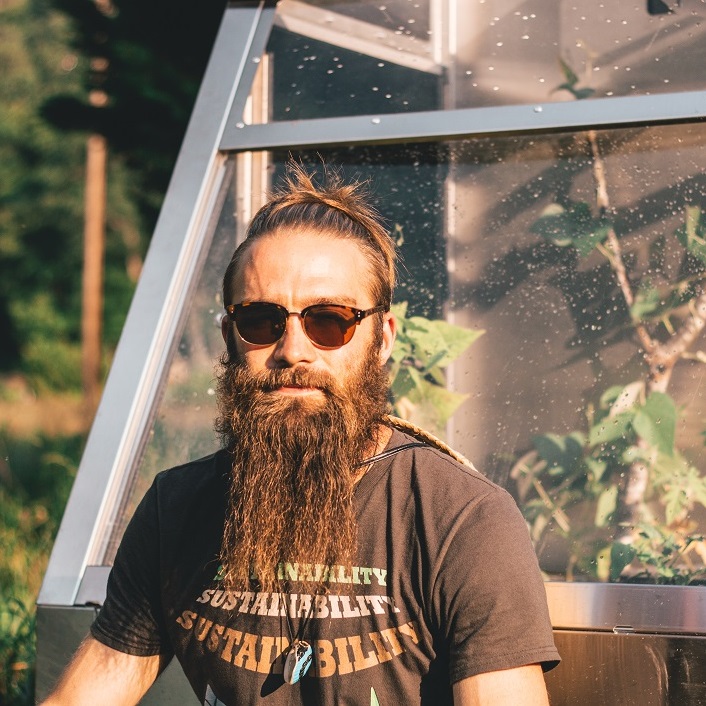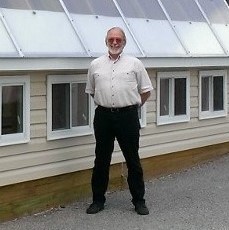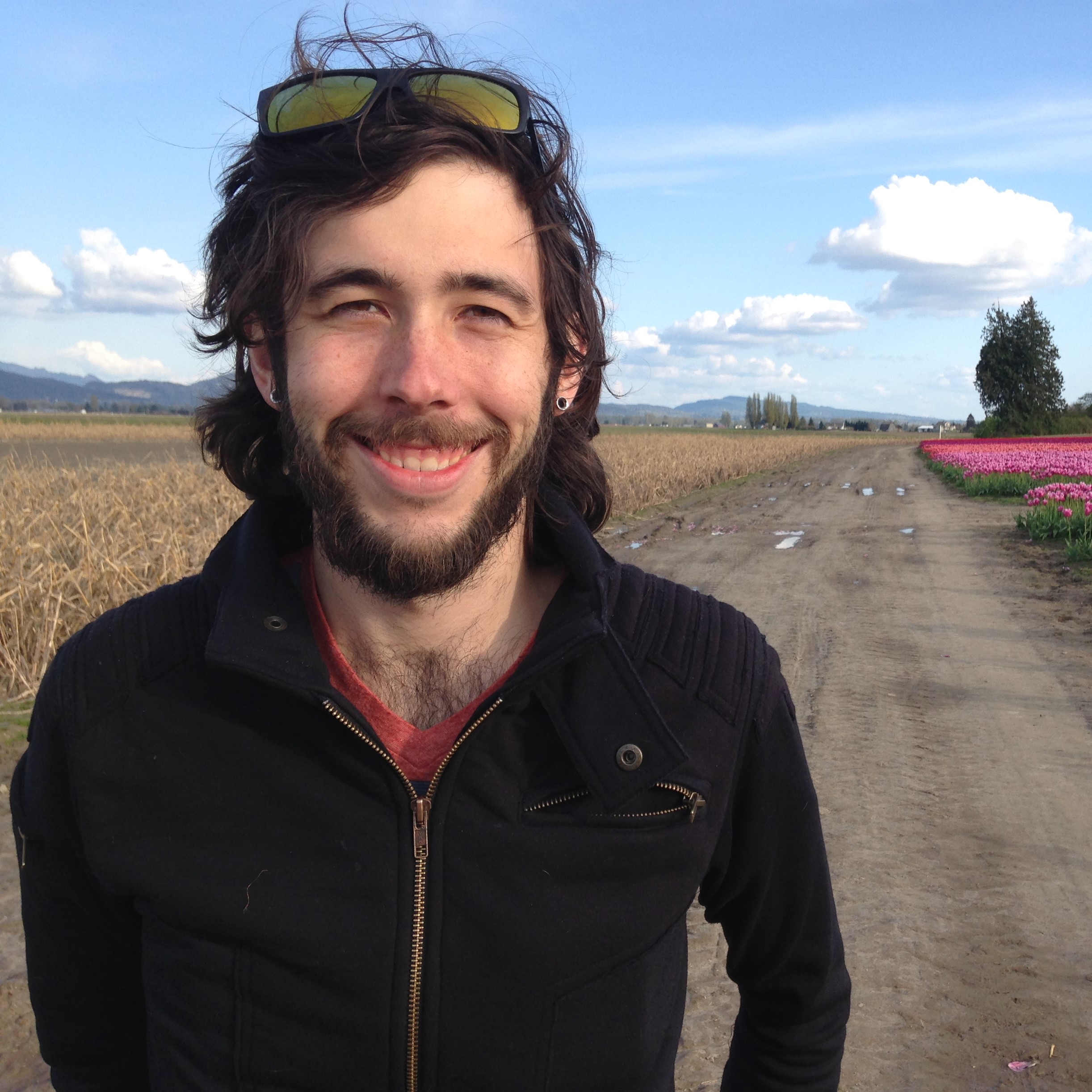Building a Full Size SunCatcher
The glazing we use is multi-layer polycarbonate. It comes in several configurations, and the version you would need will depend on your specific site and other design details such as volume-to-surface ratio, insulation, radiant barriers, angles of reflection and refraction, and more. Similar products are available in vinyl, which lasts longer but is more expensive. Other types of glazing will work, including glass. The material is not as important as its performance under your specific conditions.
In warmer climates (zone 5 or warmer) owners/builders may want to substitute fans for the window (vents) in the two upper vent spaces. The openings must be able to be well sealed and insulated as needed during cold weather. If this is done you may want to use only one or two central ceiling fan(s).
Unlike most buildings lumber used to construct a SunCatcher can be subject to exposure to moisture both inside and out during the lifetime of a structure. There are a number of woods (besides pressure treated) that are suitable for use in moist environments. Therefore, other types of wood equal to or better than pressure treated may be substituted for pressure treated lumber accordingly and in compliance with code. The builder must be careful to properly seal any materials that should not be exposed to extreme moisture.
Local solar noon is when the sun is due south of a particular location. During winter the sun is always in the southern portion of the sky as it makes its journey east to west every day. While the sun rises and sets at different times each day (depending on the date, the location and daylight savings time) the sun is due south of that particular location at exactly half way between sunrise and sunset each day. This is useful in that the shadow of objects that are perfectly straight and vertical (tool handles, a weight hanging on a string, etc.) points due north at local solar noon and can help you properly orient your SunCatcher.
Your SunCatcher ceiling fans serve two important functions:
1. Move warm air high in the SunCatcher down onto the plants on cold nights and overcast days
2. Move air up through the SunCatcher and out the top vents on sunny days if needed
To best accomplish both of these functions ceiling fan placement is very important.
The two side fans should be mounted on the rafters such that the level of the horizontal fan blade is roughly half way between the top of the door openings and the bottom edges of the upper exhaust vents.
The center fan can be mounted on the center rafter with the bottom of the fan/light about a foot above the top of the crosstie or on the center cross tie (check the distance from the floor to the bottom of the fan/light).
For best results fans should be controlled separately with variable speed three-way switches (up-down-off). It’s generally good to be able to control all the inside and outside lights separately as well.

Center Fan – Option 2
The top lip at the apex of SunCatcher serves two useful functions.
1. It provides ladder support to work on the glazing without the ladder touching the glazing surface.
2. It provides an easy place to attach an exterior shade cloth without having the cloth laying on the surface and possibly scratching the glazing.
The lip can be easily omitted during construction if desired.
Parkway, Laurel Ridge and Newton Conover use 55 gallon metal barrels filled with water as the primary source of thermal mass. The Carolina Mountain Classic SunCatcher has PCM installed in it.
Learn more about thermal mass and the other four design elements of the SunCatcher HERE.
- One option is to keep it as soil and grow directly in it.
- Another option is gravel possibly with pavers or tiles as a walkway or with the whole floor finished with pavers or tiles.
- A third option is a concrete floor which generally involves a contractor. This is the most expensive option.
- Raised beds can also be constructed inside the SunCatcher or products such as the EZ-Gro™ Garden can be used.
We make every effort to practice a green philosophy not only in our designs, but in the construction and operation processes as well. As you may already know, part of this green philosophy is to use local resources (materials and personnel) when possible. With that said, SunCatcher can usually best serve a client in an advisory role by guiding their local team through the construction process (in the long run this is usually cheaper and faster as well). You will of course have labor and materials to cover and you will need to provide a local engineer, contractor, etc. as is appropriate for your particular needs.
For best results both the exterior (that especially includes the roof) and the interior walls and ceiling should be white or very light colors to reflect the light back onto the plants. The thermal mass functions best as flat black. Red and blue are also useful colors for optimizing thermal storage and possibly reflecting light useful for photosynthesis.
The geometry of the SunCatcher is a critical factor in its performance. It is designed to optimize the availability of sunlight on a daily basis as well as during the periods when it is needed most for both photosynthesis and heating. This geometry dictates that the depth and height are roughly the same and the length must be at least twice the depth. Sometimes these unique geometry requirements may dictate using several smaller SunCatchers instead of one really large SunCatcher (which may in fact be more expensive to build for the same amount of floor space).
In addition to the solar and orientation considerations discussed on the website some practical considerations include available power and water hookups as well as access and water drainage.
Let’s start with the realization that the energy entering the SunCatcher as sunlight and all other energy used in the SunCatcher is the same amount of energy that eventually will leave the SunCatcher as heat loss. And the longer the energy entering any structure stays in the structure before leaking out, the warmer the structure becomes. So, to raise a structure’s temperature you can raise the energy input, reduce the energy output or both. For the SunCatcher design this translates into a larger aperture (to collect more energy into the system) with more insulation and possibly a night time insulating curtain (to slow the amount of energy leaving the structure), and increased thermal mass (to hold excess heat for the colder, longer periods).
SunCatcher construction time and costs can vary quite a bit due to a number of factors (materials, labor, type of floor, type of thermal mass, automation, even weather, etc.). If optimizing primarily for cost of construction, new materials (versus recycled) for a 16 x 32 SunCatcher may cost around $15,000. In general for construction by a general contractor, one may approximate that labor will contribute between 40-60% of the total cost of construction. A good estimate for both materials and construction cost would be in the range of $25,000-$40,000 for a 16 x 32 SunCatcher. The cost of a 12 x 24 SunCatcher would be less.
Another construction option which significantly reduces labor cost is building the SunCatcher using Eco-Panels’ integrated panelized building solution. The SunCatcher Eco-Shell by Eco-Panels (which is available for under $13,000) creates a very tight, structurally sound SunCatcher and reduces the labor and time needed for construction.
This varies widely from one location to another. It is wise to check the requirements at your local city/county building department before going too far with your project. The plans are engineered drawings but again one should check to insure what is required should you need a building permit.
Especially during winter months, your SunCatcher when properly sited, built, maintained and operated will provide a much enhanced thermal performance over that of other greenhouses of comparable size. This warranty does not apply where the SunCatcher is not installed and used in accordance with SunCatcher’s specifications and recommended operational procedures. The placement, orientation and attentive use of your SunCatcher is crucial to its efficiency and performance and is outside of our control, as are weather and climatic conditions, so we do not warrant that you obtain specific results or against plant loss for any reason.
Our designs certainly can be “off-the-grid”. Low/No fossil energy input is one of our design principles. This is accomplished by optimizing the insulation, thermal mass, glazing, type energy input (biogas, photovoltaics, wind etc.) and human operation.
Operating a SunCatcher
There are many factors that determined what can be grown in a SunCatcher. This is accomplished by identifying and optimizing the growing conditions for various plants. The SunCatcher Classic may very well be sufficient as is to accommodate most house and crop plants. If the plants require more, the SunCatcher insulation, thermal mass, glazing, energy input etc. can be modified to meet the particular plants’ needs.
The SunCatcher Classics are designed so that in cold climates (except the far north & south of the planet) they can sustain daytime temperatures of 80° F plus and nighttime temperatures of 45° F plus during the coldest part of the winter if adequate sunlight is available.
The SunCatcher is primarily designed to grow plants fall through spring but included in the SunCatcher are numerous ways to vent the structure and thus cool it to reduce summertime heating issues. There is in fact less direct sunlight entering the SunCatcher during the summer months.
The SunCatcher is designed to be very warm in the winter. If needed, it can also be cooled in three ways:
- Venting through the use of natural convection with warm air rising and flowing out the upper vents while cooler air flows in through lower vents. All vents can generally be left open when night time temperatures are above the mid-40s and when it is warmer outside than it is inside. The ceiling fans can also be used to assist by pulling air up and out the upper vents as needed. Read more about how ventilation works in a SunCatcher.
- Light colored reflective shade cloths can reduce the amount of direct sunlight entering the SunCatcher especially in the early fall and late spring.
- The angle of the glazing itself reflects much of the summer’s midday sun thus reducing the temperature inside the SunCatcher.
The vent opener is a mechanism attached to the vent which uses a spring loaded metal cylinder that expands to open the vent when heated. The spring closes the vent when the cylinder cools.
SunCatcher understands that not all folks can dedicate the time needed to manually operate their greenhouse. That is why SunCatcher has worked with GrowerNode™ Greenhouse Automation of British Columbia, Canada, to develop a complete automation system so a SunCatcher can be monitored and controlled from anywhere in the world via PC, tablet, or mobile device. You can track temperature, light, soil moisture, etc. and make operational changes to your vents, lights, and fans while at work or on vacation! You can add cameras, alarms, and smoke monitors for the utmost security.
More than 60% of the heat loss of the SunCatcher is through the south facing glazing and about 2/3 of that occurs at night when the structure is cooling. This is due in part to heat loss by radiation (like a camp fire or woodstove). An insulated reflective curtain can cut night time heat loss through the glazing by more than 50%. During the cold winter months closing the curtain at night will increase the temperatures inside the SunCatcher when it is most needed. In moderate climates the curtain is probably not necessary. In very cold climates it is required.
The SunCatcher is designed to vent using natural convection. The ceiling fans can be used to assist by pulling air up and out the upper vents if needed to help cool the SunCatcher. The ceiling fans can also be used on cold nights to push warm air down on plants.
Other Services and Future Initiatives
SunCatcher is developing four different sets of plans for our Classic design. They include:
16’ x 32’ with 6” walls
16’ x 32’ with 10” walls (for colder climates)
12’ x 24’ with 6” walls
12’ x 24’ with 10” walls (for colder climates)
Read more about other SunCatcher projects and initiatives.
Our normal consulting rate is $200/hour plus expenses. For more involved projects we offer an initial consulting package for $500 in advance for the first three hours, then $150/hour after that plus expenses. We can consult via email, over the phone, or consider on-site for special situations.
Typical services or input we would provide include the following, although we can certainly adapt to meet other specific needs:
- Calculate optimal orientation for your greenhouse based on location and surroundings
- Collect and interpret local solar and climate data
- Recommend the best materials to use for your requirements and situation
- Make suggestions on high level layout, which you can convert into blueprints
- Review blueprints and provide feedback
- Suggest specific growing and heating techniques to use once your greenhouse is complete, to improve its efficiency and effectiveness.
Danielle Crouse, our Grow Space Design and Passive Solar Greenhouse Operation Specialist, specializes in optimizing the growing conditions in passive solar greenhouses. She has growing experience in both conventional and passive solar greenhouses. She can help you design a grow space to best fit your needs. For beginning growers, she helps with plant propagation, pest and disease identification and management solutions. She also provides guidance in SunCatcher climate control as SunCatchers differ from traditional greenhouses in their climate management.
Your SunCatcher
Contact us and let us know! We’ll get back to you shortly and add it to the FAQ.
Note: The information and suggestions contained on the SunCatcher website are based on information SunCatcher Passive Solar Greenhouses believes to be reliable. They are offered in good faith, but without guarantee, as conditions and methods of use are beyond our control. We recommend that the prospective user determine the suitability of any product and suggestions before adopting them for a personal or commercial application.









